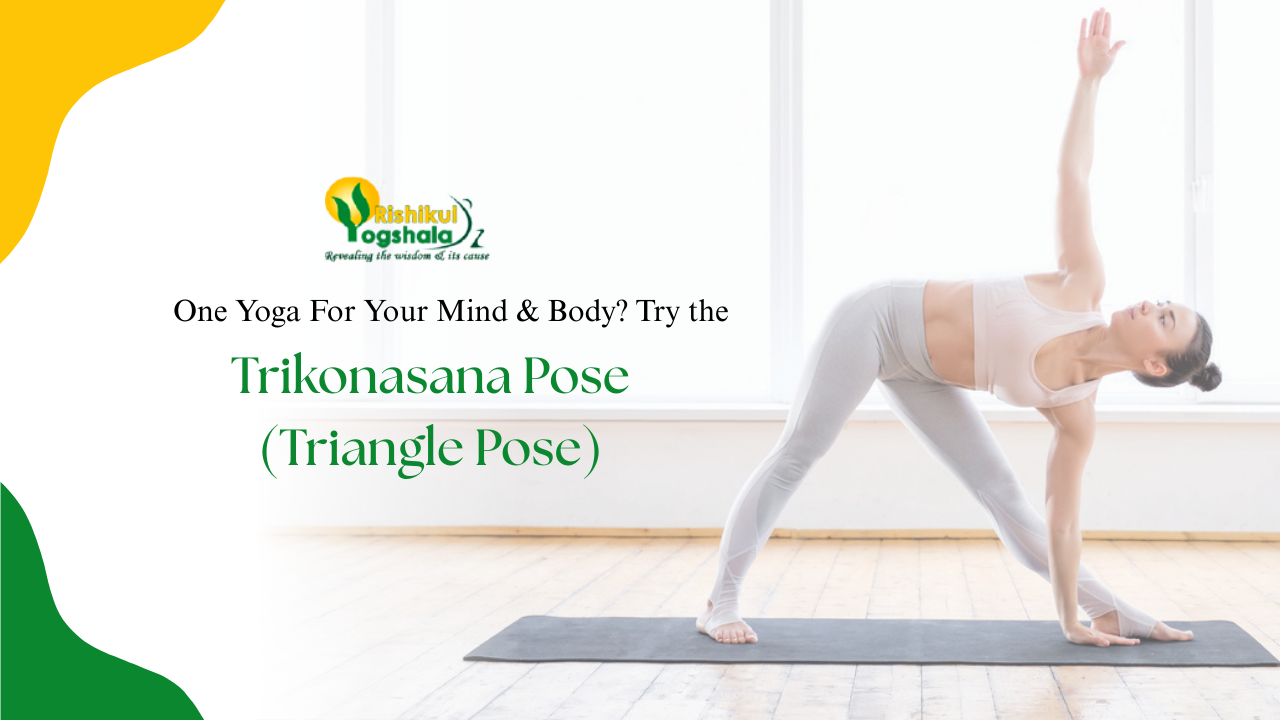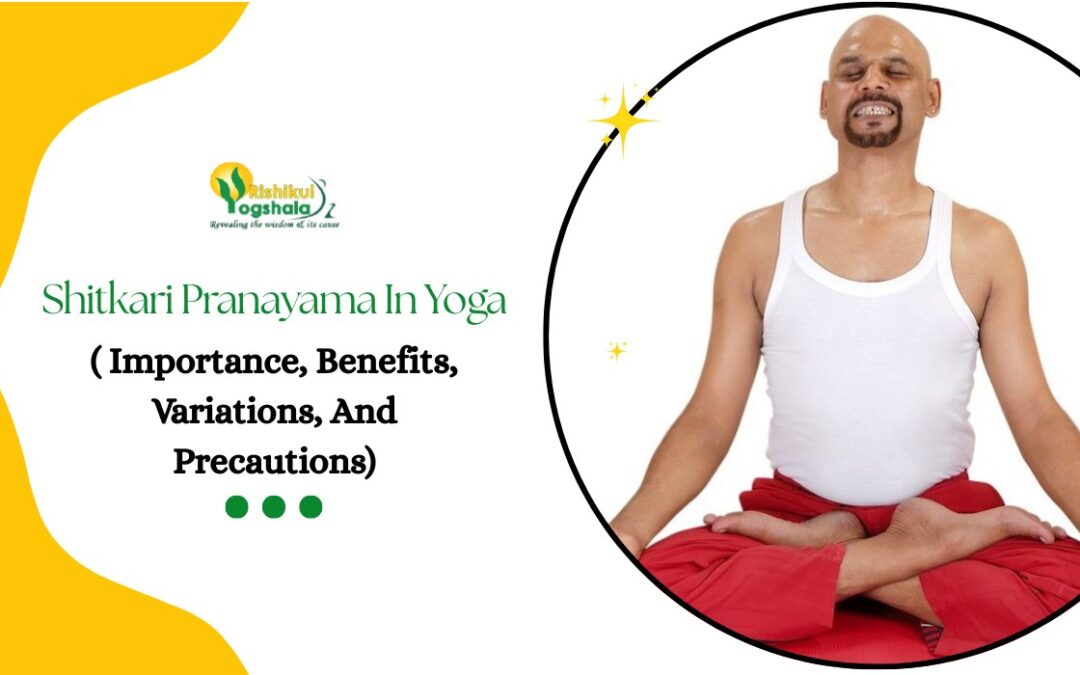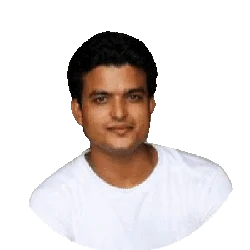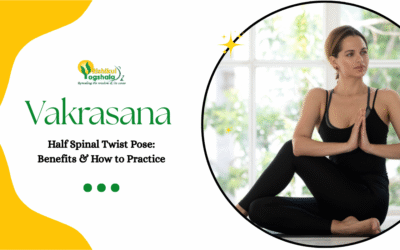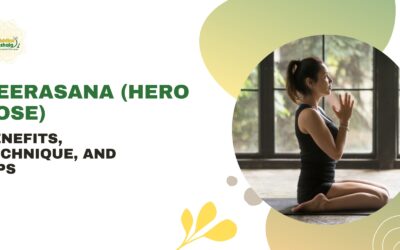Trikonasana is a standing posture asanas used in the practice of Hatha Yoga. The words Tri refer to three and Kona refers to corners. Trikonasana, thus, means “Three Corners”. The ultimate position is said to resemble a triangle created by the torso, upper limbs, and lower limbs, hence the name.
Trikonasana primarily concentrates on side stretching of the body. It could aid in increasing spinal flexibility. Additionally, it could extend the muscles in the legs and ease hip and leg stiffness. If you are looking to learn more about such yoga poses, we’d recommend signing up for our 300 hours yoga teacher training program TTC.
In this blog, we will find out the benefits of the Trikonasana pose, along with step-by-step instructions on how you can practice it at home. Lastly, we have also listed a number of variations of the Trikonasana Pose (Triangle Yoga Pose) and some crucial safety precautions.
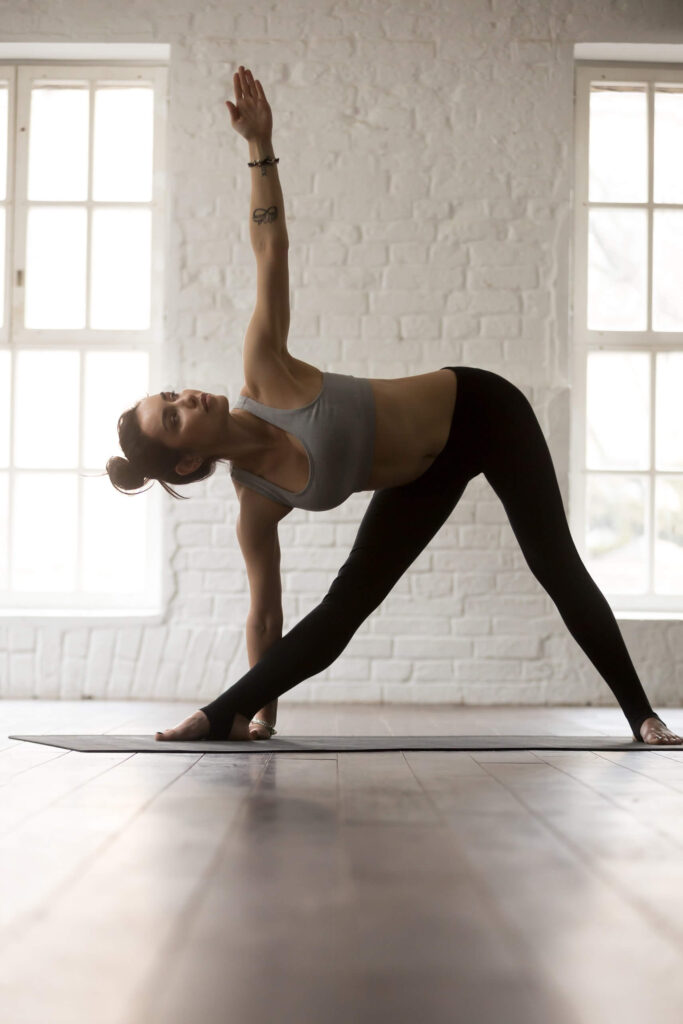
Health Benefits of Trikonasana Pose (Triangle Yoga Pose)
Trikonasana, like many other yoga postures, offers a number of benefits for your mind and body, including the following Trikonasana benefits:
- Stretch your chest and shoulders
- Trikonasana engages your core muscles, improving balance
- Trikonasana stimulates the upper and central bodies, which could improve the digestive system and perhaps increase metabolism.
- Treatment for menopausal symptoms, infertility, flat feet, neck pain, and osteoporosis
- This position helps promote flexibility by reducing stiffness in the back and spine
- The lower back, where some individuals carry their tension, can be targeted by the trikonasana pose. This pose can assist in letting go of that tension, which will lessen anxiety and promote emotional stability.
- Alleviates back pain, particularly during pregnancy
How To Do the Trikonasana Pose (Triangle Yoga Pose)
- Step your feet three to four feet apart as you come from Tadasana (Mountain Pose). With your shoulder blades open and your hands down, raise your arms so that they are parallel to the floor.
- If you’re starting on the right side, place your left foot at a 45-degree angle and your right foot at a 90-degree angle with the end of the mat.
- Turn your right foot ahead and your left foot inward so that you are facing the front of the mat. If doing so makes you more comfortable, line up your right heel with your left heel. Get your quads going.
- Grasp your ankle with your right hand as you extend your right arm all the way to your right foot. The fingers of your left hand should be pointing up at the ceiling, and your left arm should be extended upward, producing a straight vertical line with your shoulders.
- Turn your head to face the ceiling while keeping your shoulders straight. Hold for a little while, then reset to neutral and repeat with the left leg.
Safety Precautions when Practicing the Trikonasana Pose (Triangle Yoga Pose
Consult your doctor to make sure the exercise is safe for you before beginning any new routine. Even though the Trikonasana appears straightforward, improper execution might reduce its effectiveness.
Check out the following safety precautions before you perform a Trikonasana correctly:
- Resist bending your knee if you’re trying to reach for your front foot but aren’t quite able to do this might make the position less useful. If bending your knees still presents a challenge, set a yoga block next to your extended leg and utilize it as leverage.
- Support your back heel against a wall if you feel wobbly in the stance.
- The Trikonasana is a sideways hip movement done with straight arms and legs, not a forward bend. To avoid back discomfort or damage, keep your spine straight and avoid bending your back when executing Trikonasana. Instead of forming the letter “C,” your side body should look like the letter “I.”
- Try to maintain a straight line of arms from the floor to the ceiling.
- Look directly ahead or downwards at the mat if tilting your head to face the ceiling puts strain on your neck.
- Although it may be easy to accomplish, for this position to be successful, your upper body, quadriceps, and core must all be actively engaged. Keep those muscles tight as you descend into the foundation stance to get the full rewards.
- Assume you are forcing your shoulders, head, and back against a wall to maintain your back straight. Alternately, try leaning your back and body against a real wall.
Modifications of the Trikonasana Pose (Triangle Yoga Pose)
There are a few adjustments you may make to Trikonasana if you want to switch things up, like:
1. Extended Triangle Pose, or Extended Trikonasana (Utthita Trikonasana): With the exception of a wider stance to expand the pelvis and a minor change in hand placement, this modification of the triangle pose is called the extended Trikonasana, also known as the extended triangle posture (Utthita Trikonasana.
The Extended Triangle Pose involves almost the same preparation and execution as the standard Trikonasana. For instance, instead of halting at the shin or ankle while touching your left foot with your left hand, hold your big toe or rest your lower hand flat on the ground next to the foot.
2. Extended Triangle Pose with a Block: Put a block under your shoulder inside your front ankle if you’re unable to reach the floor without bending or rounding your back. You can alter the block’s height to a level that is comfortable for you.
3. Extended Triangle Pose using a chair: To improve stability and balance, rest your lower hand on a chair’s seat instead of your shin or the ground. Alternately, turn the chair around and place your hand on the back rather than the seat.
4. Extended Triangle Pose seated in a chair: Sit on the edge of a chair. Straighten the knee and gently stretch one leg to the side. Place that side arm onto your shin or thigh after outwardly rotating that thigh so your knee faces the roof. Reach up with your other arm. You can lift your eyes to your fingers if it is comfortable for your neck.
5. Revolved Trikonasana, or Revolved Triangle (Parivrtta Trikonasana)
- Keeping your arms parallel to the floor, begin in the same setup posture as a conventional or extended Trikonasana.
- Without bending your left or right knee, pivot towards your front leg while keeping your chest wide.
- Depending on which side you’re starting with, extend your right hand towards your left ankle or your left hand towards your right ankle, with your hand that is free firmly planted on your hip.
- Then, slowly twist your body until you can comfortably look up while turning your torso to look in the direction of the ankle you’re holding. To accomplish this, stoop forward till you can grab your ankle and lean toward your front heel.
Also Read – The Wonderful Yoga Poses, Asanas, and Postures You’ll Discover in Yoga Teacher Training
Final Words
Yoga must be practiced with good form and technique in order to be safe and productive. If you have a record of or existing health issues, speak with your doctor before beginning a yoga practice. You can adjust the positions based on your own requirements.
Incorporating this pose into your practice can lead to significant improvements in overall well-being. For those interested in deepening their yoga journey, consider enrolling in a yoga teacher training program. Rishikul Yogshala, a leading Yoga school in Rishikesh, offers comprehensive courses like the 100 Hour Yoga Teacher Training In Rishikesh, 200 Hour Yoga TTC In Rishikesh, 300 Hour Yoga Teacher Training In Rishikesh, and 500 Hour Yoga Teacher Training Rishikesh. These programs are designed to help you master your practice and share the transformative power of yoga with others.

